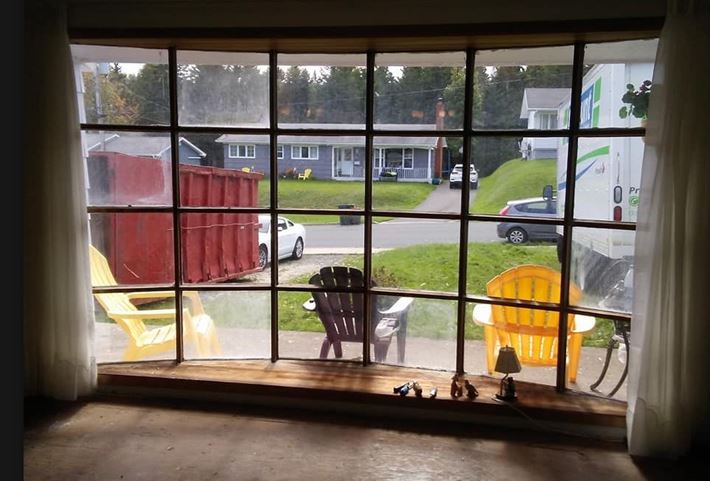Sylvia Dolomont's home is set for demolition on Thursday, October 4th, 2017. After extensions from the CBRM, she says that demolition is set to go forward despite her continued objections and indications of progress. Previously referred to as a "hoarder" in media reports, on Thursday she posted photos of the home to Facebook. Despite the highly damaged interior, the photos demonstrate that the home has been fully emptied of its contents.
A community supporter also posted a long note that describes some of the history of Dolomont and her home and invites the public to see the home prior to its demolition. See below in full:
11:41 p.m. Wednesday update: City hall lawyer Demetri Kachafanas stated the demolition is scheduled for tomorrow (Thursday).
==============
A LONG SAD STORY ABOUT TO GET EVEN SADDER. The history of Sylvia Dolomont, an elderly hoarder living in North Sydney, Cape Breton, is full of hope and tragedy.
It’s a tragedy because her house is about to be torn down.
Sylvia, in her 70s, a lifelong resident of Cape Breton, was the youngest of 13 children. Her father died when she was a toddler. Her mother kept the family going by hauling bootleg coal. They were often hungry to the point of starving. For a while, they lived in a neighbour’s chicken barn. Sylvia remembers her mother lying huddled under blankets, covered in snow that drifted through the cracks in the roof.
Sylvia married at 18 and had her first son a few months later. Her husband worked on the Coast Guard. Together, they built their first home in North Sydney, then, when two more sons came along, they built a larger house on Campbell Street.
Sylvia never drank, never did drugs, did her best to be honest. She was faithful to her husband their entire lives. But she had a mental disorder, hoarding, which likely started in her 20s. Throwing anything in the garbage terrified her, in case it was needed later. Her husband took out the trash, and she would tiptoe outside and bring it back into the house.
For the most part, her sons and husband covered up her disorder. The family lived quietly. If neighbours suspected something was wrong, they didn’t ask.
That went on for decades until the sons grew up and moved away and eventually, Sylvia’s husband fell ill and died. After that, with nobody to take care of her, Sylvia’s hoarding spiralled out of control until the house was so full of garbage — along with hundreds of bags of brand new, unopened items that she bought on the shopping channel and at local stores — that there was no room left to walk in the house. All rooms were piled waist deep.
So, she bought a second house. Her husband left her with a good pension and she had savings from looking after elderly people for many years. Soon, however, the second house was in a similar state.
Meanwhile, thieves targeted the first house, ransacked it, vandalized it. Neighbours complained repeatedly to city hall.
Although there is a church three doors away, not one neighbour approached Sylvia to offer help.
City hall sent orders, threatened to throw Sylvia in a mental hospital and tear down the house. After decades of reclusive hoarding, she didn’t know where to start.
Eventually, city hall ordered the house to be demolished. Nobody discussed what would happen to Sylvia, whether she would end up on the streets. Maybe they hoped she would just quietly disappear.
That’s where I come in. I am a journalist, and I covered the city council meeting when Sylvia gathered up her courage and tried to convince city hall to leave her alone. She failed.
Two days later, she called me, and we talked for an hour. Her bravery in the face of overwhelming odds caught my attention. I said that if she found a few other people to help, I would help her straighten out the house.
She found a fire chief, a grocery store manager, a woman who runs a hairdressing school who brought six students and others. We told city hall what we were doing, and they held off on the demolition.
We packed new goods into totes, filled five large dumpsters with debris. We ripped out carpets, threw out moldy furniture, washed curtains, cleared out cupboards.
We got a building inspector’s report confirming that the building was structurally sound. It needed a lot of work, but it would be a sin to tear it down.
The bathroom took me two days. It was so full that the door was blocked and barely opened. I stood in the hall and clawed the contents out a fistful at a time.
I spent more than 100 hours working in that house with Sylvia. We talked so much. I am just a reporter, not a health care professional at all, but Sylvia was easy going, and she listened to suggestions. Little by little, she changed. For a woman in her 70s, it was remarkable.
I should mention that Sylvia is intelligent and has a great sense of humour. She lost 75 pounds because she wanted to. How many people can claim that?
Her disorder did not develop because she chose to be that way. She will likely always need a little support, but she was so determined and so cheerful about saving the house that it was hard not to be inspired. We talked about other ways than shopping to be happy, and about the joy of light and air and space, and how to reward herself for doing the right thing.
However, we could not work hard or fast enough for city hall. The volunteers put in great efforts, but the work was huge. I only had weekends available. No matter how much we slogged, it wasn’t good enough for the neighbours -- who continued to complain, who still never offered to help.
City hall pulled artificial deadlines out of the air. We tried, but couldn’t meet them. At one point, we asked a judge for help. She issued a temporary injunction, then backed out, saying it wasn’t an appropriate matter for the courts.
Last week, we received a list of outrageous requirements from city hall, things it had no right to demand of a citizen -- and only eight days to comply. All contents, even new, unopened items, had to be removed from the house. An environmental company had to test and remediate the home. It had to be insured. Etc. Etc.
I found one environmental company available, but mould testing alone takes 10 days. That wasn’t good enough for city hall.
The house is not a bother to anyone. It looks like an ordinary bungalow on an ordinary street, but after all our efforts, all of Sylvia’s progress and her remarkable turn-around, the city lawyer has said the bulldozer will arrive any day now.
Sylvia would like to invite you to come to the house to see if city hall made the right decision. Inside, the house still needs a lot of work. We know that, and we had a plan, but it has been ripped out from under us.
If you go, please remember how the house was when we started: waist-deep after decades of hoarding and no help. And consider if we have made progress. If you think it would be a sin to tear down the house, please tell city hall.
The address is 59 Campbell Street, North Sydney.
You can reach the mayor at [email protected]






0
Log In or Sign Up to add a comment.- 1
arrow-eseek-eNo items to displayFacebook Comments